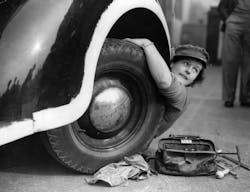Maintenance Horror Stories: All You Need Is A Flashlight
There is no place where the adage “You can pay me now or you can pay me later” is more valid than in truck maintenance.
Consider these two repair horror stories from Gordon Botts, owner of Botts Welding & Truck Service, Woodstock, Ill., who has seen a lot of things in his 50 years repairing trucks. They could have been prevented with something as simple as time, attention and a flashlight.
Recently Botts had a garbage truck with broken torque rods ends in one of the bays at his repair garage. “Nobody was keeping their eyes on the transverse torque rod and as a result the ends broke off. I have never seen anything that bad,” he says.
Had the fleet bothered to do a preventive maintenance inspection and brought the truck in when they first noticed a problem then Botts would have only had to replace the two torque rods and the attaching hardware for a cost of about $600. But since the fleet continued to run the truck with the torque rods completely worn out, “the suspension was getting too much back and forth motion which led to breaking both walking beams, both saddles and both frame hangers.” The cost for this repair? $7,000.
The next story involves another fleet that failed to inspect the torque rods on its truck. As a result a ball stud broke off both the front and back differential. “This allowed the front differential to cock down. It threw the bogie shaft out of the truck onto the highway. And it completely destroyed the front differential and front driveshaft. The invoice for this repair? $8,000. Cost for a timely repair? $500.
All of this could have been prevented had either fleet taken a few minutes to do a simple check. “All they needed was a flashlight, or cheaper still sunlight,” Botts says. “When they are greasing the driveshaft — which they should be doing once a month — all they have to do is look up. The torque rods are about 12 inches above the driveshaft and with a little light are easy to see.”
And if something seems off when looking at them, Botts suggests taking a pry bar up and try to move them. “If they are moving, they are bad. It’s really pretty simple.”
So why aren’t fleets taking the time to perform proper maintenance? Sometimes it’s a matter of feeling they can’t take a truck out of service. Botts explains that the cost of today’s trucks have caused fleets to purchase only the exact number of trucks they need.
“Twenty years ago it was not uncommon for a disposal fleet of 70 trucks to have five spares so they could afford to shut a truck down to do proper maintenance.” The competiveness of today’s market has put pressure for fleets to keep their trucks on the road, Botts believes. But without taking time to perform proper maintenance, your fleet will have horror stories of its own to share.
